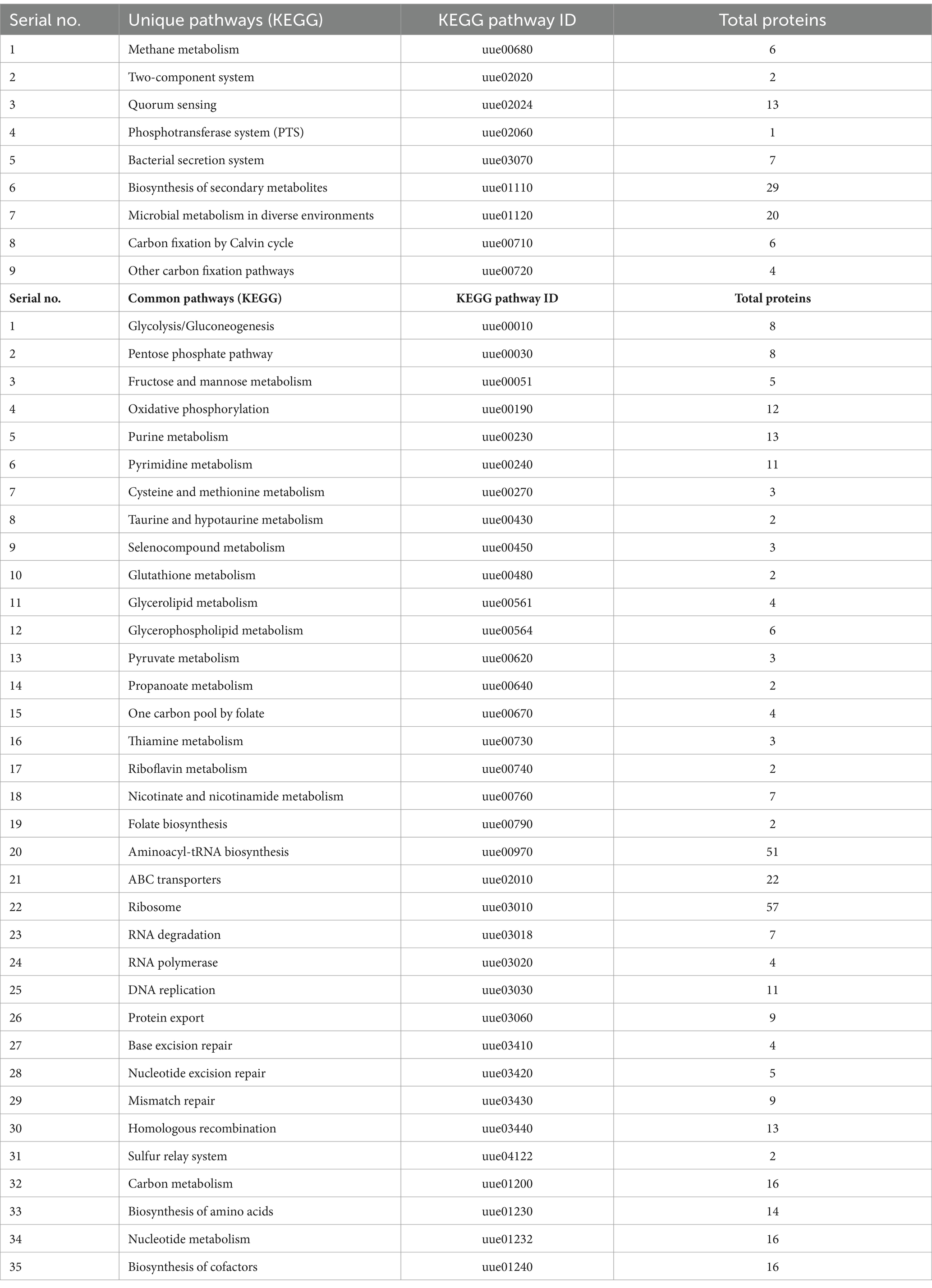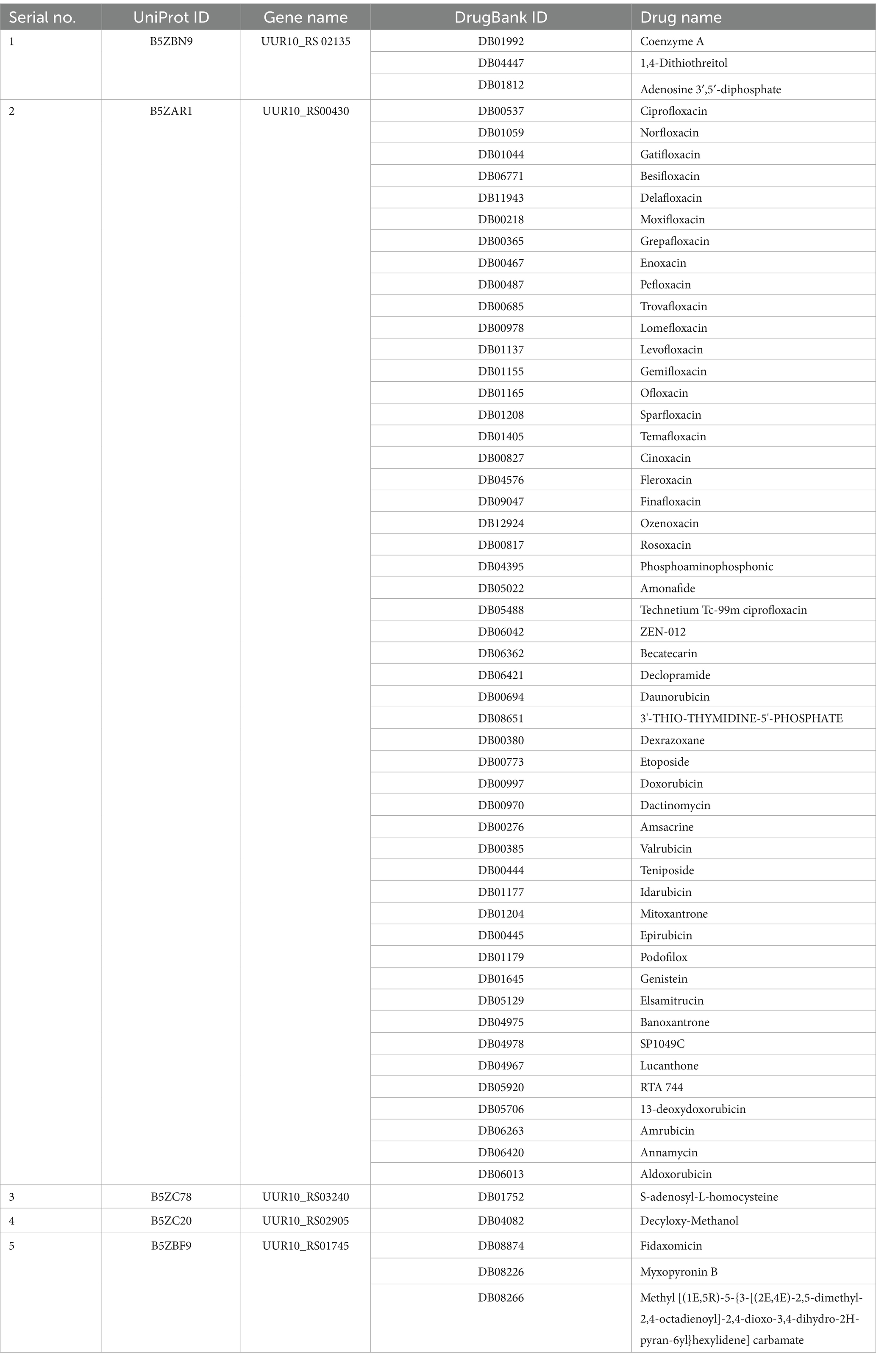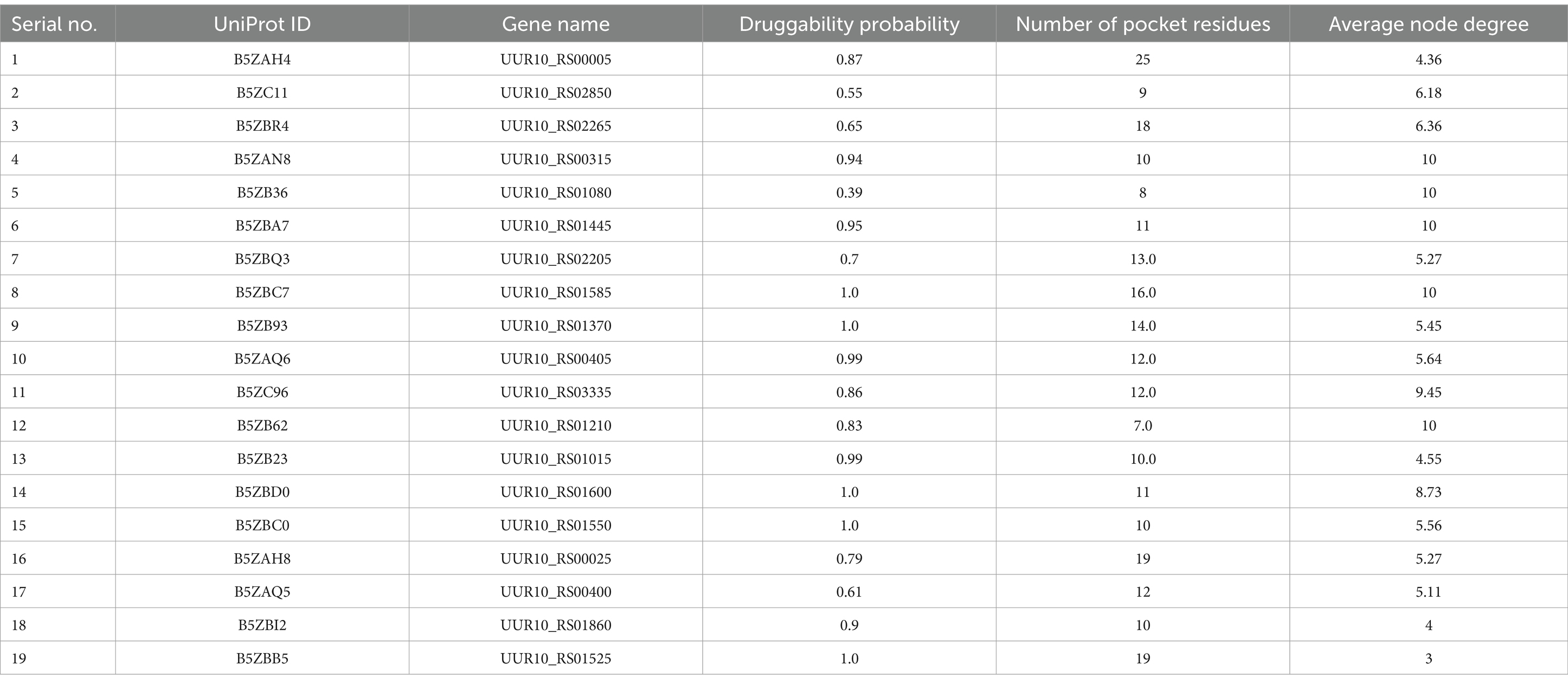- 1Institute of Pathogenic Biology, School of Basic Medical Sciences, Hengyang Medical School, University of South China, Hengyang, China
- 2Hunan Provincial Key Laboratory for Special Pathogens Prevention and Control, University of South China, Hengyang, China
- 3Special Inspection Department, Hengyang Traditional Chinese Medicine Hospital, Hengyang, China
- 4Center for Medical Test and Pathology, The First Affiliated Hospital of Hunan University of Chinese Medicine, Changsha, China
Introduction: Ureaplasma urealyticum is a commensal organism found in the human lower genitourinary tract, which can cause urogenital infections and complications in susceptible individuals. The emergence of antibiotic resistance, coupled with the absence of vaccines, underscores the necessity for new drug targets to effectively treat U. urealyticum infections.
Methods: We employed a subtractive genomics approach combined with comparative metabolic pathway analysis to identify novel drug targets against U. urealyticum infection. The complete proteomes of 13 Ureaplasma strains were analyzed using various subtractive genomics methods to systematically identify unique proteins. Subsequently, the shortlisted proteins were selected for further structure-based studies.
Results: Our subtractive genomics analysis successfully narrowed down the proteomes of the 13 Ureaplasma strains to two target proteins, B5ZC96 and B5ZAH8. After further in-depth analyses, the results suggested that these two proteins may serve as novel therapeutic targets against U. urealyticum infection.
Discussion: The identification of B5ZC96 and B5ZAH8 as novel drug targets marked a significant advancement toward developing new therapeutic strategies against U. urealyticum infections. These proteins could serve as foundational elements for the development of lead drug candidates aimed at inhibiting their function, thereby mitigating the risk of drug-resistant infections. The potential to target these proteins without inducing side effects, owing to their specificity to U. urealyticum, positions them as promising candidates for further research and development. This study establishes a framework for targeted therapy against U. urealyticum, which could be particularly beneficial in the context of escalating antibiotic resistance.
1 Introduction
Ureaplasma urealyticum, which falls under the category of Mollicutes, is a prevalent mucosal commensal capable of self-replication and cell-free survival (Glass et al., 2000). This microorganism typically inhabits the lower urinary and reproductive systems in humans and can be transmitted through sexual contact (Kawai et al., 2015). Accumulating reports suggest that U. urealyticum is gaining recognition as a significant sexually transmitted pathogen. It is causally associated with various conditions, including non-gonococcal urethritis, infertility, chorioamnionitis (Yang et al., 2020), prostatitis, epididymitis (Pollack, 2001), cervicitis, bacterial vaginosis, pelvic inflammatory disease, reactive arthritis, spontaneous abortion, prematurity, intrauterine growth retardation, postpartum fever, and extragenital disease (Capoccia et al., 2013; Waites et al., 2005). Additionally, it poses a serious threat to newborns and individuals with weakened immune systems as it can lead to severe infections (Bharat et al., 2015; Deetjen et al., 2014; Pollack, 2001; Sprong et al., 2020). Noteworthy, U. urealyticum typically results in asymptomatic or chronic persistent infection with observable clinical symptoms. Currently, tetracycline, quinolone and macrolide antibiotics are generally considered the primary treatment options for U. urealyticum infection (Kawai et al., 2015). However, the rapid emergence of antimicrobial resistance among clinical strains has compromised the effectiveness of these available drugs (Zhang et al., 2023; Ma et al., 2021; Beeton et al., 2009; Kong et al., 2022; Yang et al., 2020). Consequently, the treatment of U. urealyticum infection remains a formidable challenge.
The urgent need to explore new therapeutic targets in this bacterium is highlighted by the global increase in antibiotic resistance and the absence of a licensed vaccine. The post-genomic era and advancements in high-throughput sequencing have paved the way for the development of well-established tools for analyzing big data. These tools have opened up new avenues for identifying novel drug targets. Currently, subtractive genomics analysis is universally utilized to discover potential drug targets against various pathogenic bacteria, including Chlamydia trachomatis (Aslam et al., 2021), Vibrio parahaemolyticus (Liu et al., 2023), Mycobacterium tuberculosis (Uddin et al., 2018), Salmonella Typhi (Jalal et al., 2021), Staphylococcus aureus (Naorem et al., 2022), Streptococcus pneumoniae (Khan K. et al., 2022), Mycoplasma genitalium (Nogueira et al., 2021), and Haemophilus ducreyi (de Sarom et al., 2018). This approach, which involves differentiating the pathogen proteome from the host proteome to identify non-host essential proteins, offers a more efficient and cost-effective alternative to traditional disease-based drug development methods. Through in-silico analysis, suitable drug targets for U. urealyticum can be explored.
To date, there have been no reported therapeutic targets concerning the metabolic pathways unique to U. urealyticum. In this study, we utilize extensive subtractive genomics and comparative analysis of metabolic pathways to uncover promising therapeutic targets against U. urealyticum by leveraging the existing sequenced genomes. Moreover, we performed virtual high-throughput screening of FDA-approved and FDA-experimental drugs, and identified potential candidates with inhibitory activity against shortlisted drug target proteins.
2 Materials and methods
The workflow used in this study for the prediction of putative drug targets against U. urealyticum infection is detailed in Figure 1.

Figure 1. Systemic workflow of novel drug targets identification using subtractive genomics and comparative metabolic pathways analysis (By Figdraw).
2.1 Acquisition of genomics information and core proteomics investigation
The genetic information of selected strains within the Ureaplasma sp. (Supplementary Table S1) was gathered from the GenBank database at the National Center for Biotechnology Information (NCBI), which functions as a central repository for biomedical and genomics data. In order to maintain uniformity in genome annotations, the RAST server (Rapid Annotations using Subsystems Technology) (Overbeek et al., 2014) was utilized to annotate all of the genomes. The analysis of the core proteome among 13 genomes was conducted using reciprocal best BLAST hits of all coding sequences in the EDGAR version 3.0 software framework (Dieckmann et al., 2021). For this analysis, the genome of U. urealyticum serovar 10 str. ATCC 33699 was chosen as the reference genome, and the genomes of the remaining strains were compared to the reference.
2.2 Identification of human host non-homologous essential proteins
The duplicated copies or redundant sequences from the main protein set were eliminated by implementing the CD-HIT module within the CD-HIT suite (Li and Godzik, 2006). To be considered redundant, the sequence identity had to exceed a specific cutoff of 0.6 (or 60%). For the subsequent analysis, priority was given to the protein sequences that were not duplicates. To identify the essential proteins of U. urealyticum, the core set of proteins was further assessed using GEPTOP version 2.0 (Naorem et al., 2022). An essentiality score cutoff of 0.24 was utilized. The GEPTOP platform was employed to detect essential genes in prokaryotic organisms. This was achieved by comparing the orthology and phylogeny of the query proteins with the experimentally defined datasets in the database of essential genes (DEG). After identifying non-duplicated protein sequences deemed essential, a BLASTp search against the Homo sapiens genome was conducted using the threshold E-value cutoff of 10−4. Any resulting sequences showing significant similarity to the human host were disregarded, while sequences with no homology were chosen for downstream analysis.
2.3 Identification of metabolic pathways in the pathogen and human host
To identify metabolic pathways in the human host and U. urealyticum, we utilized the Kyoto Encyclopedia of Genes and Genomes (KEGG) and the Automatic Annotation Server (KAAS). Using the KEGG database, we retrieved unique identification numbers for the metabolic pathways in H. sapiens and U. urealyticum. We then conducted a manual comparison to distinguish exclusive from shared pathways. Pathways exclusive to the pathogen were labeled as unique metabolic pathways, while those found in both the human host and the pathogen were identified as common metabolic pathways. In this research, the protein sequences implicated in the pathogen’s unique metabolic pathways, as well as proteins annotated with KO numbers but not associated with neither specific nor common pathways, were screened for subsequent detailed analysis.
2.4 Analysis of subcellular localization
To prioritize proteins found in the cytoplasm for assessing potential therapeutic targets, we first utilized the PSORTb version 3.0.3 server (Yu et al., 2010) to predict the subcellular localization of these proteins. To enhance the credibility of the PSORTb version 3.0.3 findings, we subsequently validated them through the BUSCA (Savojardo et al., 2018) and CELLO version 2.5 (Yu et al., 2006) servers. The most accurate results from the localization analysis were determined by aggregating the data from these three servers. The final protein localization result was the same location predicted by two or more servers.
2.5 Druggability analysis of screened proteins
The ability of a target to bind with drugs and drug-like molecules at a high affinity determines its druggability. To evaluate the druggability of crucial cytoplasmic proteins, Blastp was used to search for them in the DrugBank database, accessible at https://go.drugbank.com/. DrugBank is a valuable resource for bioinformatics and cheminformatics, offering extensive information on drugs and their targets. Potential drug targets or drugs were identified by considering proteins with an E value below 10−5. In instances where no matches to known drugs or drug targets were found, these proteins were classified as novel drug targets of U. urealyticum (Khan M. T. et al., 2022). The DrugBank non-homologous proteins were then prioritized for druggability assessment based on druggability probability via the PockDrug server (Hussein et al., 2015) and their protein–protein interaction characteristics retrieved from STRING version 12.0 database (Szklarczyk et al., 2023).
2.6 Anti-target analysis of shortlisted novel drug targets
In the field of host cell biology, proteins that act as anti-targets are of great significance due to their ability to bind with potential therapeutic compounds designed to combat corresponding pathogens. Among the human population, a comprehensive search of the existing literature discovered 210 such proteins (Fatoba et al., 2021). Noteworthy examples of these proteins include P-glycoprotein (referred to as P-gly), adrenergic receptor, dopaminergic receptor, and ether-a-go-go-related protein. In order to minimize any negative consequences resulting from the interaction between these anti-target proteins and the proposed drug targets, a thorough analysis was performed. The novel drug targets were subjected to a search using NCBI BLASTp against these 210 anti-target proteins, applying the following criteria: an E-value of less than 0.005, a query coverage greater than 30%, and an identity below 30%.
2.7 Analysis of non-homologous proteins in the human microbiome
Accidental blockage or unintentional inhibition of proteins found within the gastrointestinal microflora may result in dysbiosis, significantly affecting the microenvironment and possibly causing toxicity with adverse effects on the human host (Sarker et al., 2023). Essential non-homologous proteins, identified as potential novel drug targets, underwent screening via BLASTp, applying an E-value threshold of less than 0.005, a query coverage exceeding 30%, and an identity percentage below 30%. This analysis utilized the dataset available on the Human Microbiome Project server1 under “43,021 (BioProject)” (Khan K. et al., 2022; Peterson et al., 2009). Proteins exhibiting less than 30% similarity were classified as novel therapeutic targets and proceeded to the subsequent phase.
2.8 Structure modeling and validation
The target proteins analyzed in this study underwent structure prediction using the SWISS-MODEL program (Waterhouse et al., 2018) accessed through the Expasy web server, known for its comprehensive homology modeling service. The accurate evaluation of the 3D model is of paramount importance in the field of computational structure prediction (Senior et al., 2020). Recent advancements in sequencing techniques have led to groundbreaking discoveries in computational structural biology (Mendez et al., 2023; Tripathi et al., 2019). The introduction of widely accepted and efficient techniques for structure evaluation has enabled the qualitative estimation of protein structures. In this research, three distinct tools, namely PROCHECK (Laskowski et al., 1996), ERRAT (Colovos and Yeates, 1993) and ProsA-web (Wiederstein and Sippl, 2007), were utilized to assess the stereochemical quality and accuracy of the predicted models (Hooda et al., 2012).
2.9 Ligand library preparation for virtual screening
To identify a suitable target for drug development, it is essential to investigate the interactions between the drug target and potential drug or drug-like compounds. Consequently, it is necessary to search for suitable ligand molecules that are capable of binding to the target proteins. In preparing the ligands library, we selected the FDA-approved drug library, which contains 2,470 drugs, along with an experimental drug library comprising 6,041 drugs (Gan et al., 2023). All drug molecules were obtained from DrugBank in the structured data file (SDF) format. The structures of these drug molecules were subjected to energy minimization and subsequently compiled into a ligands library designed for virtual screening.
2.10 Virtual high-throughput screening
The recently developed DrugRep server2 facilitated the execution of virtual high-throughput screening as an online tool for computer-aided drug discovery. In the process of virtual screening with DrugRep, the structures of well-prepared drug target proteins underwent receptor-based virtual screening against a library of ligands that included 8,511 distinct drug molecules. For the docking procedure, the DrugRep server employed Autodock Vina (Trott and Olson, 2010) to identify potential inhibitors against the drug target proteins and returned 100 best molecules based on estimated binding affinities (kcal/mol).
2.11 Receptor–ligand complex analysis
To elucidate the interaction dynamics between the receptors (shortlisted drug target proteins) and the ligands (the top-ranked drug molecules), the tools AutoDock Vina and PoseEdit were employed. The PoseEdit tool was sourced from the ProteinsPlus Server.3 An examination was performed on both receptors alongside their respective ligands to evaluate interactions, binding conformations, and affinities. Furthermore, the Top-10 screened drugs underwent filtering based on Lipinski’s rule of five (RO5). Ultimately, the ligands that demonstrated the most advantageous binding affinities were selected according to their optimal docking scores and adherence to RO5.
2.12 Molecular dynamics simulations
All-atom MD simulations were conducted using small molecule-protein complexes derived from docking as the initial structures, employing Gromacs 2023.3 software (Pronk et al., 2013; Rodríguez-Martínez et al., 2024). Both the small molecule and the protein were represented using the AMBER protein force field (Wang et al., 2004; Maier et al., 2015). The pdb2gmx tool was utilized to incorporate hydrogen atoms into the system, followed by the addition of a truncated cubic TIP3P water box at a distance of 10 Å from the system. Sodium (Na+) and chloride (Cl−) ions were included to neutralize the system’s charge (Bejagam et al., 2018). Subsequently, the topological and parameter files for the simulations were generated. MD simulations were executed with Gromacs 2023.3 software for a total simulation duration of 100 ns (Case et al., 2005). Prior to the simulations, energy minimization was performed using the mdrun command and the steepest descent method within the NVT ensemble, with an initial step size of 0.01 nm and a maximum force tolerance of 1,000 kJ/mol•nm. Following energy minimization, a 100 ps NVT (isothermal-isochoric) ensemble simulation was conducted at constant volume, with gradual heating from 0 to 310.15 K to facilitate the even distribution of solvent molecules within the solvent box. This was succeeded by a 100 ps NPT (isothermal-isobaric) ensemble simulation, employing the Berendsen barostat to equilibrate the system pressure at 1 bar. During the MD simulations, all hydrogen bonds were constrained using the LINCS algorithm, with an integration step size of 2 fs. Long-range electrostatic interactions were calculated using the Particle Mesh Ewald (PME) method, with a cutoff of 1.2 nm. The cutoff for nonbonded interactions was set to 10 Å, and these interactions were updated every 10 steps. The resulting trajectories underwent periodic boundary condition removal, after which root-mean-square deviation (RMSD), root-mean-square fluctuation (RMSF), and radius of gyration (Rg) analyses were performed.
3 Results
3.1 Prediction of the core proteome
In our study, a total of 396 coding DNA sequences (CDs) were discovered to be present in all 13 strains. These CDs were converted into protein sequences and defined as the core proteome (Supplementary Sequence file 1). In order to verify the uniqueness of the identified protein sequences, we employed the CD-HIT web server with a 60% identity cutoff. Our analysis conclusively showed that all 396 protein sequences were distinct from any paralogous counterparts.
3.2 Identification of human host non-homologous essential proteins
The 396 unique protein sequences underwent analysis using the GEPTOP server, identifying 170 sequences as essential proteins (Supplementary Sequence file 2). These vital proteins, crucial for the pathogen’s survival within the host, serve as potential targets for drug development. However, these proteins must not bear resemblance to human proteins to avoid potential drug-related complications. To address this requirement, the 170 essential proteins were compared against human (H. sapiens) proteins using BLASTp, resulting in 94 sequences identified as essential and non-homologous proteins (Supplementary Sequence file 3).
3.3 Metabolic pathways analysis
The KEGG database currently catalogs 44 metabolic pathways for U. urealyticum and 358 for human. By manually comparing these metabolic pathways between the pathogenic U. urealyticum and its human host, we identified 9 unique pathways specific to the pathogen and 35 pathways that are common to both the pathogen and the host, as detailed in Table 1. Furthermore, an analysis conducted using the KAAS server demonstrated that out of 94 proteins screened from the previous step, 92 had assigned KEGG orthology (KO) identifiers. Notably, among these 92 proteins, four were only linked with unique metabolic pathways exclusive to the pathogen, as illustrated in Table 2, and 21 were involved in neither unique nor common metabolic pathways (Supplementary Table S2). All of these 25 proteins were selected for further investigation. The remaining 67 proteins were excluded from further analysis because they were found to participate in the common metabolic pathways.
3.4 Subcellular localization prediction
The analysis conducted with the PSORTb, BUSCA, and CELLO servers identified that among the 25 proteins screened, a significant majority, specifically 24 proteins, were categorized as cytoplasmic proteins, as detailed in Supplementary Table S3. This classification indicates that these cytoplasmic proteins might play pivotal roles within cellular processes, enhancing their relevance in drug development. Consequently, given their potential as effective drug target candidates, these proteins were selected for subsequent more in-depth investigation.
3.5 Novel drug target prediction
A total of five proteins exhibited similarity to the available drug targets documented in the DrugBank database (Table 3). Conversely, the other 19 proteins displayed no matches with any entries currently identified in DrugBank. This observation indicates their potential as novel drug targets for U. urealyticum. Among those 19 proteins, 18 possess suitable binding pockets that have a druggability probability exceeding 0.5 (Table 4). Additionally, protein–protein interaction (PPI) analysis recognized 15 of these proteins as hub proteins, fulfilling the requisite threshold of a node degree of at least 5 (Aslam et al., 2021), as indicated in the STRING version 12.0 database (Table 4). Following the elimination of the five proteins that did not meet the specified parameters, each of the remaining 14 hub proteins was found to interact with several proteins (Figure 2). These hub proteins are integral to a variety of functions, and the inhibition of their activities may affect the functions of other interacting proteins. Moreover, these 14 unique therapeutic proteins lacked similarity to 210 identified human “anti-targets.” Furthermore, a BLASTp analysis conducted on all microbial strains from the Human Microbiome Project (HMP) utilizing the NCBI blast server demonstrated that only two out of the 14 proteins showed a similarity of less than 30%. Given their unique properties and the absence of overlaps with common host-pathogen pathways and human “anti-targets,” it is advisable to assess these two proteins (B5ZC96 and B5ZAH8) as promising candidates for drug targeting.
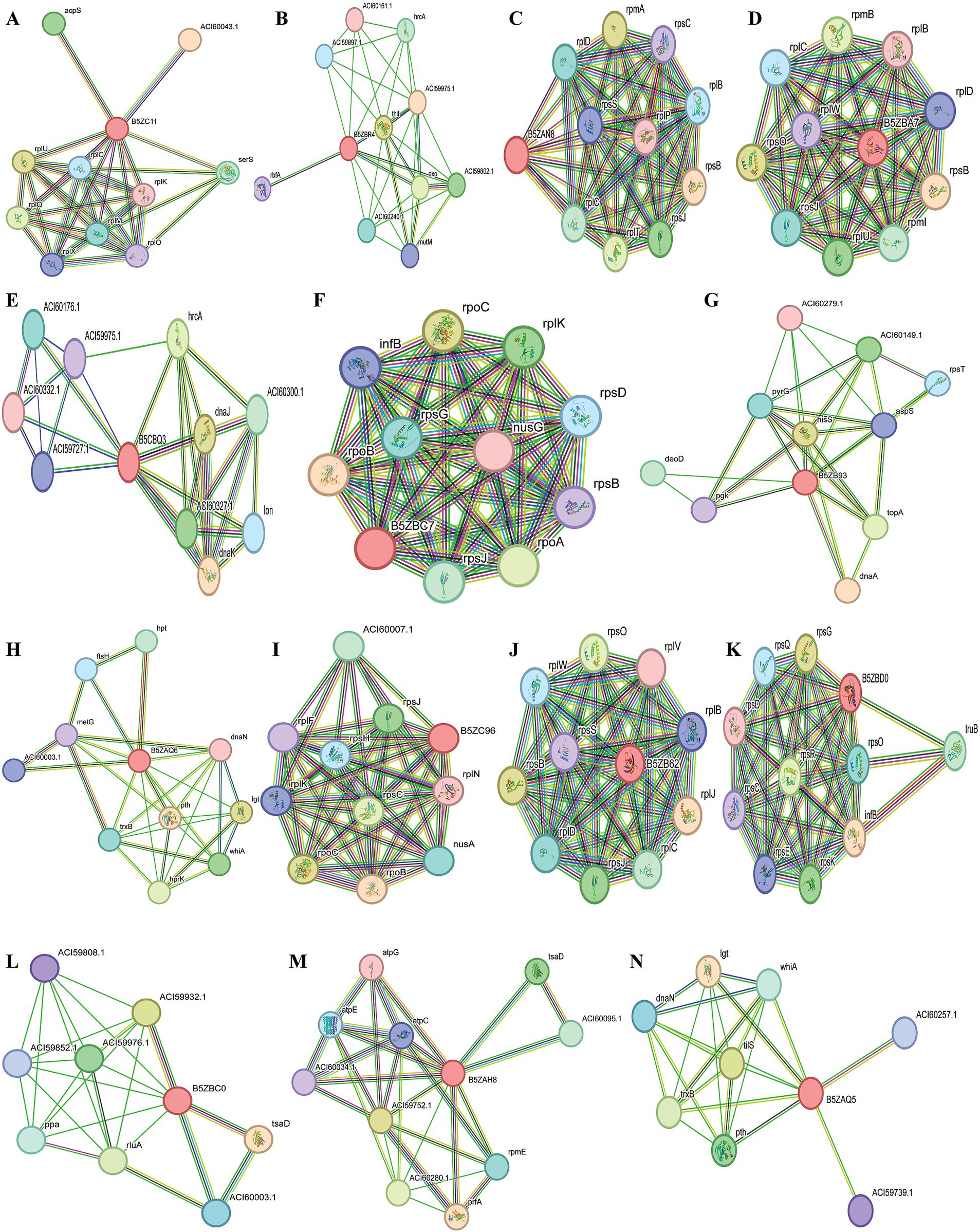
Figure 2. Schematic PPI network generated through the string v12.0 server for (A) B5ZC11, (B) B5ZBR4, (C) B5ZAN8, (D) B5ZBA7, (E) B5ZBQ3, (F)B5ZBC7, (G) B5ZB93, (H) B5ZAQ6, (I) B5ZC96, (J) B5ZB62, (K) B5ZBD0, (L) B5ZBC0, (M) B5ZAH8 and (N) B5ZAQ5.
3.6 Comparative structure homology modeling and validation
Due to the unavailability of the desired protein 3D structures in the Protein Data Bank (PDB), the homology modeling for each protein was conducted by utilizing the FASTA sequences sourced from the UniProt database, specifically for the proteins with accession numbers B5ZC96 and B5ZAH8. The AlphaFold DB model of C0AGN1 was selected as the template for the homology modeling of B5ZC96 (Figure 3A) based on optimal GMQE values and sequence similarities, while the AlphaFold DB model of C0AGQ9 served as the template for modeling B5ZAH8 (Figure 3B). With these chosen template proteins, the 3D structures of both proteins were successfully modeled.
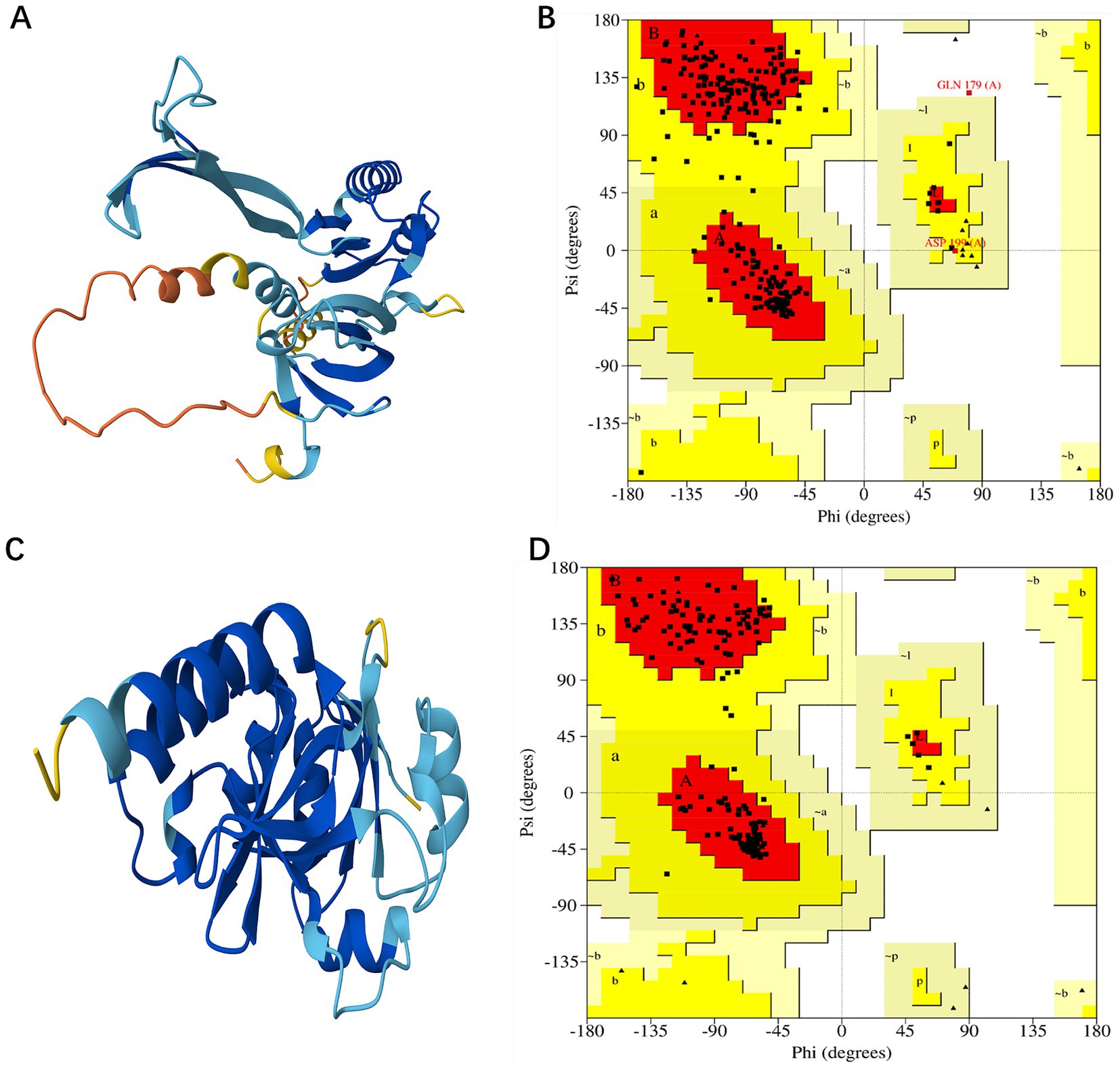
Figure 3. Modeled structure of shortlisted drug targets: (A) Three-dimensional structure of B5ZC96, (B) Ramachandran plot of B5ZC96, (C) Three-dimensional structure of B5ZAH8, and (D) Ramachandran plot of B5ZAH8.
The validation of the developed models was performed using the PROCHECK, ERRAT, and ProSA-Web tools. For the protein B5ZC96, the Ramachandran plot revealed that approximately 88.1% of the residues are situated in the most favored regions, with 11.1% located in the additionally allowed regions, and both 0.4% of the residues found in the generously allowed and disallowed regions, as illustrated in Figure 3C. Conversely, concerning B5ZAH8, the Ramachandran plot indicated that nearly 92.9% of the residues resided in favorable areas, 7.1% in additionally allowed regions, and neither the generously allowed nor disallowed regions contained any residues (Figure 3D). Furthermore, the ERRAT plot provided an overall quality factor of 87.2038 for B5ZC96 and a perfect score of 100 for B5ZAH8, suggesting that the proposed models exhibit excellent quality. Additionally, the ProSA tool’s cross-validation of the modeled structures yielded a Z-score of −6.11 for B5ZC96 and −8.36 for B5ZAH8, indicating that these models are consistent with structures derived from NMR/X-ray crystallography.
3.7 Virtual high-throughput screening
The DrugRep server conducted a virtual high-throughput screening involving a set of 8,511 unique drug molecules. Our docking analysis indicated that the docking scores for the top 10 candidates ranged from −8.7 to −7.8 kcal/mol at the B5ZC96 active site, implying a significant affinity for this target protein (Table 5). Regarding RO5, the compounds 2-[3-({Methyl[1-(2-Naphthoyl)Piperidin-4-Yl]Amino}Carbonyl)-2-Naphthyl]-1-(1-Naphthyl)-2-Oxoethylphosphonic Acid, Irinotecan, and 3-(1 h-Indol-3-Yl)-2-[4-(4-Phenyl-Piperidin-1-Yl)-Benzenesulfonylamino]-Propionic Acid showed violations associated with molecular weight (MW), exceeding the ideal upper limit of 500 g/mol. Additionally, both 2-[3-({Methyl[1-(2-Naphthoyl)Piperidin-4-Yl]Amino}Carbonyl)-2-Naphthyl]-1-(1-Naphthyl)-2-Oxoethylphosphonic Acid and Pimozide went beyond the LogP constraint, exceeding the suggested threshold of 5. Furthermore, 2-[3-({Methyl[1-(2-Naphthoyl)Piperidin-4-Yl]Amino}Carbonyl)-2-Naphthyl]-1-(1-Naphthyl)-2-Oxoethylphosphonic Acid also violated the criteria for rotatable bonds, surpassing the preferred number of less than 10. Nevertheless, since Irinotecan and Pimozide have previously received FDA approval, it is unlikely that these two inhibitors will adversely impact pharmacokinetic properties. The remaining drugs complied closely with the RO5 criteria.
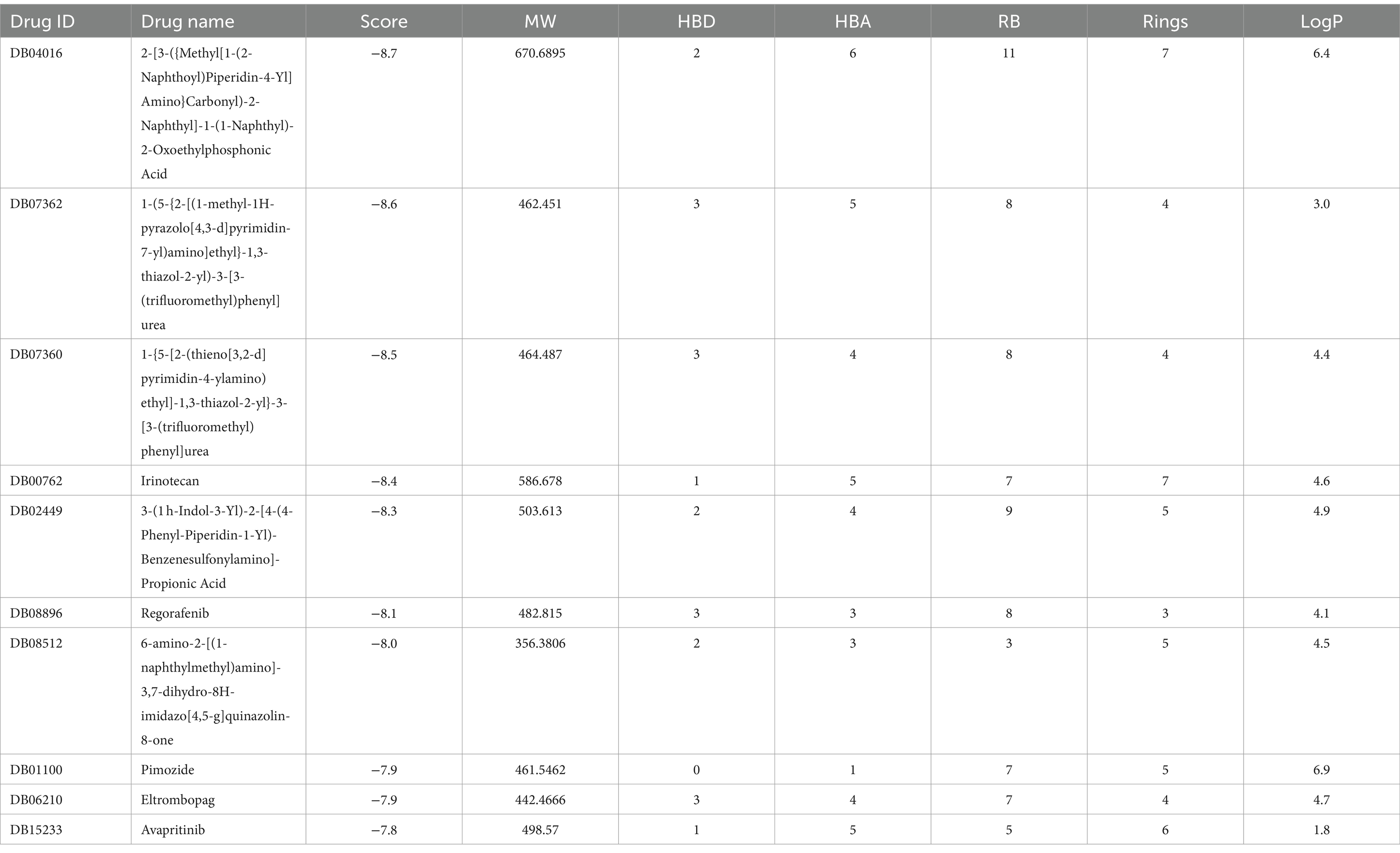
Table 5. Binding affinities as well as Lipinski’s rule of five of top-10 inhibitors targeting B5ZC96.
In addition, the binding energy for the leading 10 drugs concerning the B5ZAH8 receptor was significantly higher than that for the top 10 drugs targeting B5ZC96 (Table 6). The energy values for the top 10 drugs were established to be between −9.8 and − 9.0 kcal/mol. All top 10 drugs fulfilled the required RO5 parameters, with the exceptions of Zk-806450, 3-(2-aminoquinazolin-6-yl)-1-(3,3-dimethylindolin-6-yl)-4-methylpyridin-2(1H)-one and Arotinoid acid, each of which demonstrated a LogP violation exceeding 5, and Fluazuron, which violates both the LogP threshold greater than five and the MW limit of 500 g/mol (Table 6).
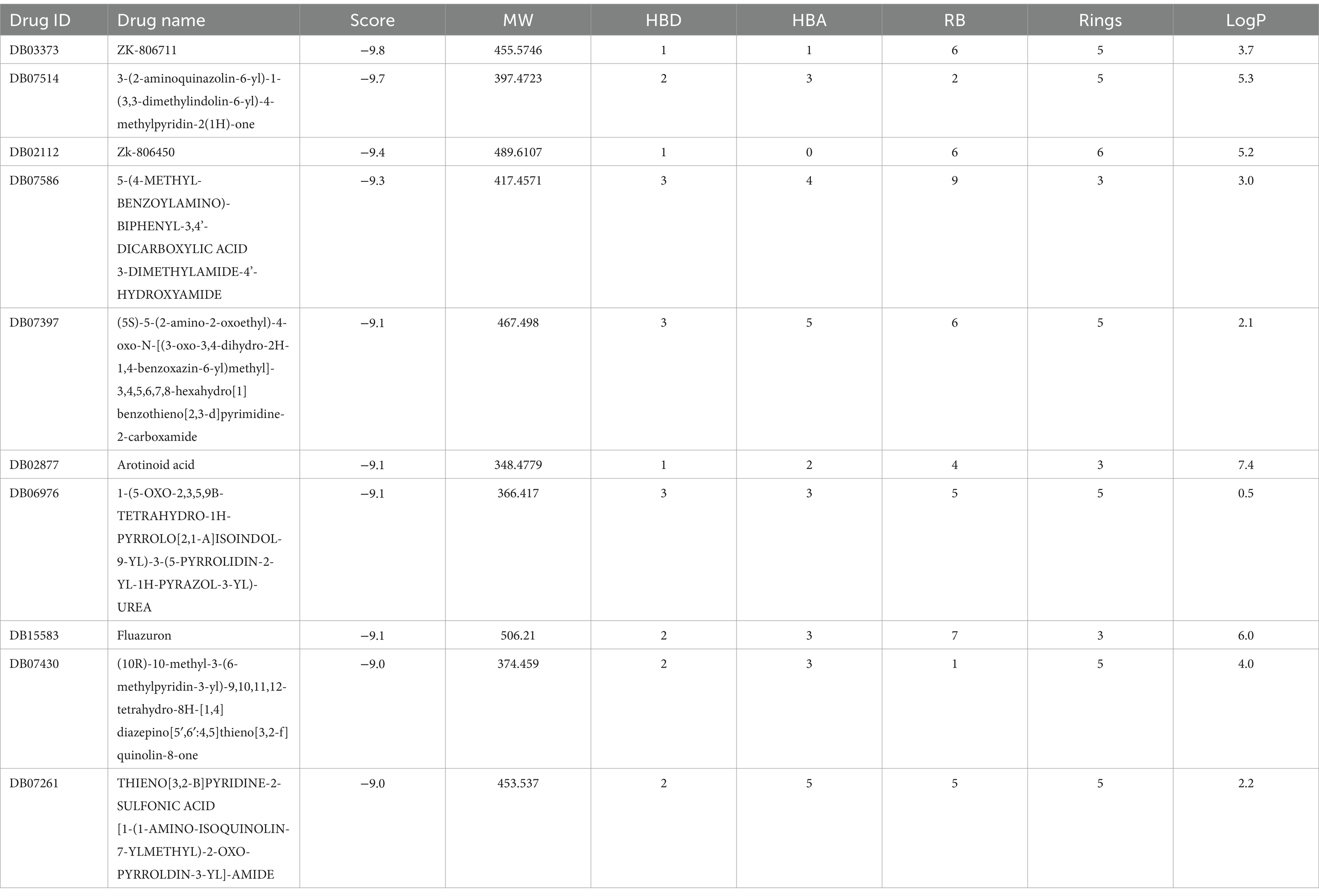
Table 6. Binding affinities as well as Lipinski’s rule of five of top-10 inhibitors targeting B5ZAH8.
3.8 Receptor–ligand complex analysis
Following the docking and sorting processes, the Top-10 molecules evaluated for each drug target demonstrated the lowest docking scores. According to RO5 filtering criteria, the compound 1-(5-{2-[(1-methyl-1H-pyrazolo[4,3-d]pyrimidin-7-yl)amino]ethyl}-1,3-thiazol-2-yl)-3-[3-(trifluoromethyl) phenyl]urea was identified as the best ligand for B5ZC96, while ZK-806711 was recognized as the optimal ligand for B5ZAH8. The two-dimensional structure and binding conformations of the best ligand for each target protein were illustrated in Figure 4. These binding configurations were generated utilizing the DrugRep server. Following the completion of the docking process, further analysis revealed that the compound 1-(5-{2-[(1-methyl-1H-pyrazolo[4,3-d]pyrimidin-7-yl)amino]ethyl}-1,3-thiazol-2-yl)-3-[3-(trifluoromethyl)phenyl]urea mediated two pi bonds with Phe111 and Tyr114 (Figure 5A), whereas ZK-806711 mediated three pi bonds with Phe55 and single hydrogen bond with Ser111(Figure 5B).
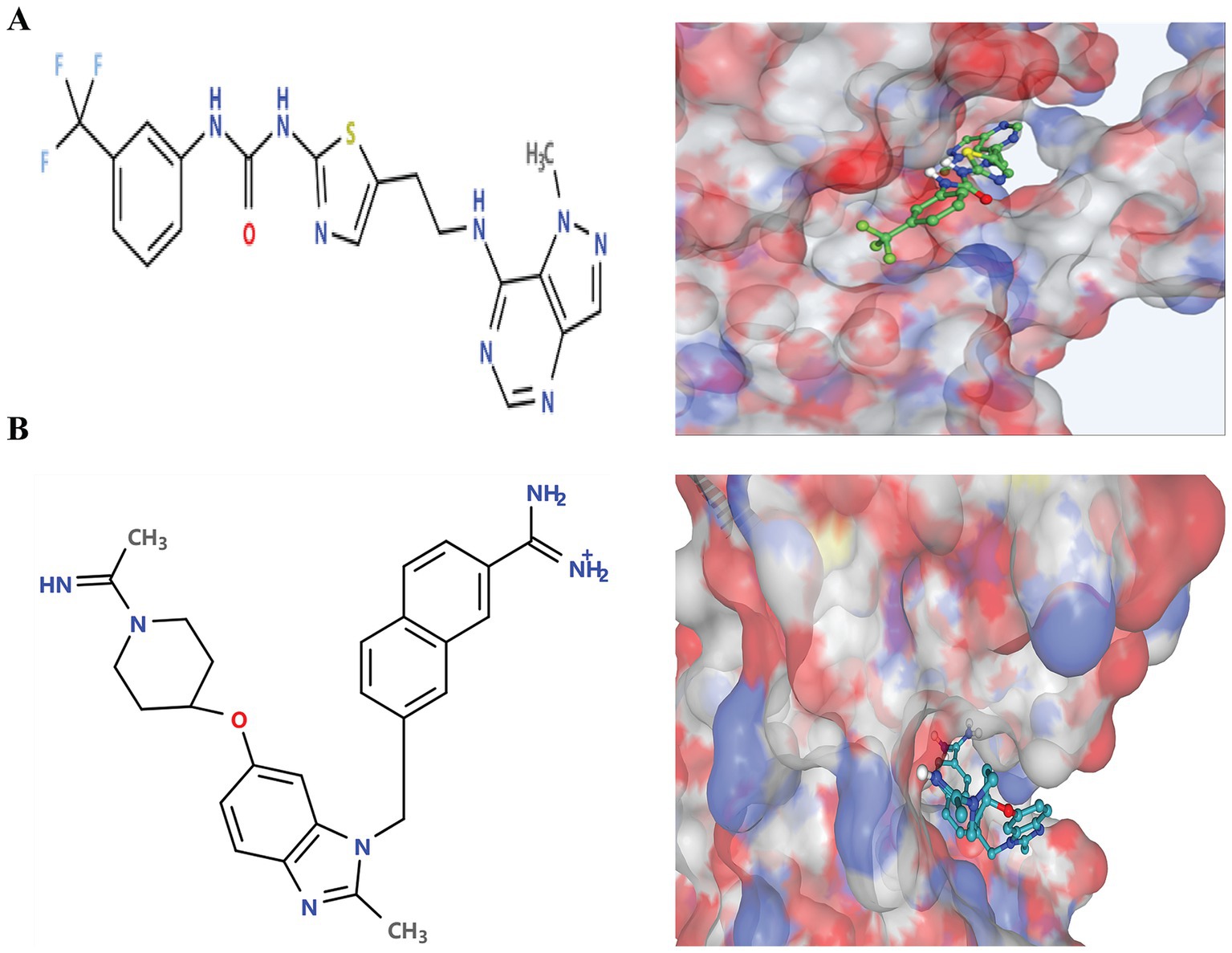
Figure 4. Two-Dimensional structures of optimal ligands and their binding configurations with respective target protein: (A) Two-Dimensional structure of 1-(5-{2-[(1-methyl-1H-pyrazolo[4,3-d]pyrimidin-7-yl)amino]ethyl}-1,3-thiazol-2-yl)-3-[3-(trifluoromethyl)phenyl]urea (left) and binding configurations with B5ZC96 (right), and (B) Two-Dimensional structure of ZK-806711 (left) and binding configurations with B5ZAH8 (right).
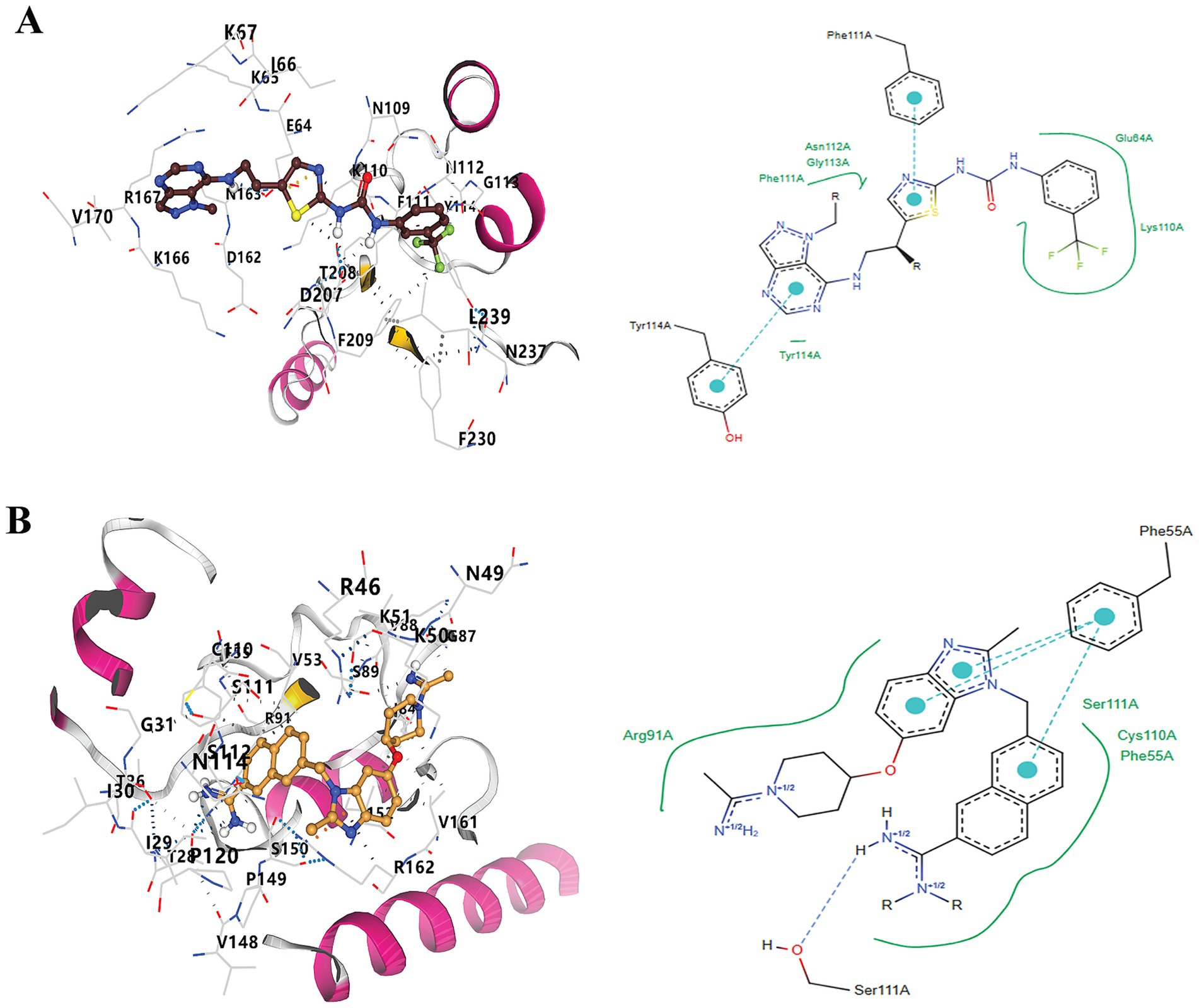
Figure 5. Docking of optimal ligands with their respective drug target proteins. (A). Three-Dimensional and two-Dimensional interaction diagram of 1-(5-{2-[(1-methyl-1H-pyrazolo[4,3-d]pyrimidin-7-yl)amino]ethyl}-1,3-thiazol-2-yl)-3-[3-(trifluoromethyl)phenyl]urea with B5ZC96, and (B) Three-Dimensional and two-Dimensional interaction diagram of ZK-806711with B5ZAH8.
3.9 MD simulations analyses
The receptor-ligand complexes underwent 100 ns MD simulations using Gromacs. RMSD was employed to assess stability, with lower values indicating greater stability. For B5ZC96, the RMSD curve initially increased as the small molecule adapted within the binding cavity, stabilizing around 10 ns at 0.2 nm. Oscillations were observed around 50 ns but stabilized by 75 ns. Throughout the simulation, the small molecule maintained stable interactions, with minor adjustments reflected in the RMSD fluctuations (Figure 6A). In the case of B5ZAH8, the RMSD curve raised to 0.5 nm before stabilizing around 0.45 nm, subsequently dropping to 0.3 nm near the end of the simulation. The small molecule exhibited no significant displacement relative to the protein, maintaining stable interactions. Minor adjustments and the rotation of an alkyl chain contributed to the fluctuations observed in the RMSD curve (Figure 6B).
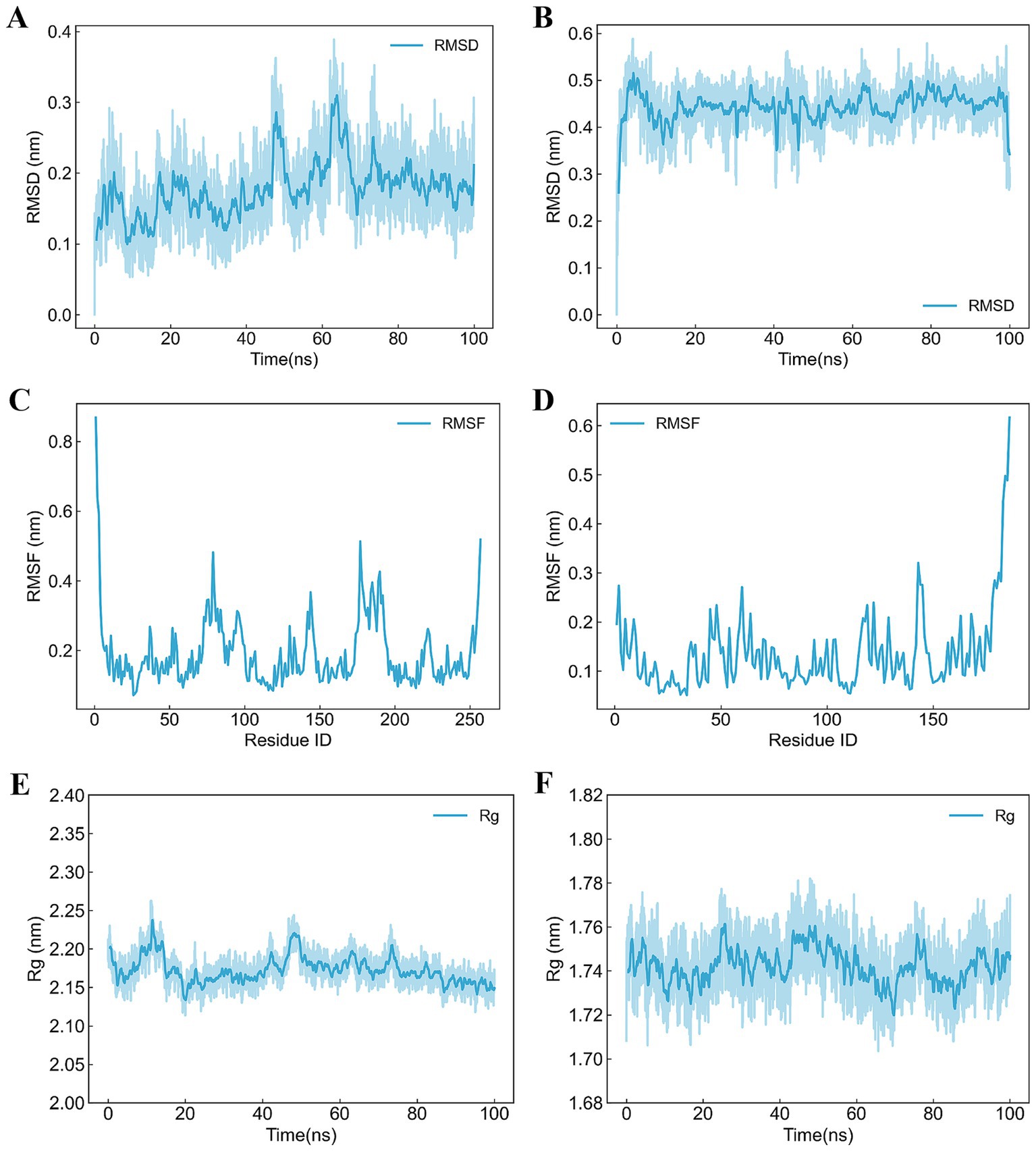
Figure 6. Trajectory analyses of receptor-ligand complexes over 100 ns molecular dynamics simulation. (A) RMSD analysis of B5ZC96–1-(5-{2-[(1-methyl-1H-pyrazolo[4,3-d]pyrimidin-7-yl)amino]ethyl}-1,3-thiazol-2-yl)-3-[3-(trifluoromethyl)phenyl]urea, (B) RMSD analysis of B5ZAH8-ZK-806711, (C) RMSF analysis of B5ZC96–1-(5-{2-[(1-methyl-1H-pyrazolo[4,3-d]pyrimidin-7-yl)amino]ethyl}-1,3-thiazol-2-yl)-3-[3-(trifluoromethyl)phenyl]urea, (D) RMSF analysis of B5ZAH8-ZK-806711, (E) Rg analysis of B5ZC96–1-(5-{2-[(1-methyl-1H-pyrazolo[4,3-d]pyrimidin-7-yl)amino]ethyl}-1,3-thiazol-2-yl)-3-[3-(trifluoromethyl)phenyl]urea, and (F) Rg analysis of B5ZAH8-ZK-806711.
RMSF, assessed by the average deviation for each residue, was analyzed to evaluate receptor-ligand binding and protein dynamics. For B5ZC96, overall RMSF values were low, with increased values observed at the N- and C-termini due to their less constrained positions. Elevated RMSF in other regions may result from small molecule interactions or intrinsic flexibility (Figure 6C). Similarly, for B5ZAH8, RMSF values also remained low, with higher values at the N- and C-termini for analogous reasons. Increased RMSF in other regions might stem from small molecule interactions or inherent flexibility (Figure 6D). Low RMSF values suggest minimal fluctuations, indicating stable vibrations in the solvent environment and consistent sampling and analysis throughout the simulation.
Rg was a metric that reflected the compactness of protein structures and can also be utilized to assess changes in the looseness of the protein’s polypeptide chain during simulations. For B5ZC96, the analysis of the Rg curve indicated that during the initial 60 ns of the simulation, Rg exhibited fluctuations, gradually decreasing from approximately 2.20 nm to around 2.15 nm. In the subsequent 40 ns, Rg stabilized, exhibiting minimal fluctuations around 2.15 nm until the end of the simulation (Figure 6E). In contrast, for B5ZAH8, the examination of the Rg curve demonstrated that the protein’s Rg values oscillated within a narrow range of 1.72 nm to 1.76 nm throughout the entire duration of the simulation (Figure 6F).
4 Discussion
U. urealyticum has emerged as an important parasitic pathogen associated with various urogenital infections, underscoring the pressing need for effective treatment options. The management of U. urealyticum infection is further complicated by the increasing prevalence of antibiotic resistance. Commonly used antibiotics are losing their efficacy due to the development of resistance mechanisms, including genetic mutations (Kawai et al., 2015; Piccinelli et al., 2017) and biofilm formation (Feng et al., 2015; García-Castillo et al., 2008). This escalating resistance not only makes treatment more challenging but also raises concerns about the potential for treatment failures and the risk of recurrent infections. In light of the limitations of current therapeutic approaches and the troubling rise in resistance, it is imperative to explore new drug targets and therapeutic strategies. Therefore, addressing the challenges posed by antibiotic resistance and the need for innovative treatment options is vital for enhancing clinical outcomes for patients. Notably, the distinct biological characteristics of U. urealyticum, including its genomic adaptations and metabolic pathways (Pollack, 2001), offer a chance to discover new antimicrobial agents that can effectively combat the increasingly resistant landscape. Consequently, the primary objective of this study was to identify and evaluate novel drug targets through an integrated approach that combines subtractive genomics with comparative metabolic pathway profiling.
Through extensive proteome analysis, we identified 170 essential non-homologous proteins in U. urealyticum. To ensure the reliability of our findings, we employed a rigorous methodology. Utilizing EDGAR v3.0 software, we conducted a core proteome analysis on 13 Ureaplasma strains, encompassing 7,689 proteins and revealing 396 core proteins. Subsequent BLAST comparisons validated the consistent presence of these core proteins across all strains. We employed the CD-HIT server to confirm the absence of paralogous proteins and further analyzed the core proteome using the GEPTOP server, leading to the identification of 170 essential protein sequences. Our results were cross-verified with the DEG database, acknowledging that while this database may list proteins that are not essential during the in vivo infection phase, it has been well-documented in existing literature as identifying reliable novel drug targets. The 170 essential proteins are likely vital for the pathogen’s survival within the host. However, targeting these proteins may have detrimental consequences and disrupt metabolic processes. Therefore, we conducted Blastp analyses to select non-homologous proteins absent in the H. sapiens proteome, thereby minimizing potential adverse effects and cross-reactivity. Our analysis indicated that 94 of the 170 essential proteins exhibited no significant similarity to the human proteome. By focusing on these proteins, we could potentially eradicate the bacteria and address associated diseases. Consequently, these non-homologous essential proteins should be prioritized as targets in the future development of antimicrobial drugs and vaccines. It is meritorious to note that with a view to exhaustively validating our screening outputs, genome-level target knockout of 94 selected genes will be a necessary task in subsequent in-depth studies.
In a comparative analysis of metabolic pathways, we identified differences between the metabolic pathways of U. urealyticum and the human host. Previous studies have predominantly focused on proteins involved in the unique metabolic pathways of pathogens (Khan M. T. et al., 2022; Aslam et al., 2021; Alhamhoom et al., 2022). Our method also includes the proteins with KO numbers that do not participate in unique metabolic pathways or in shared metabolic pathways. This strategy not only enhances the specificity of drug targeting and minimizes potential off-target effects, but also broadens the effective scope of drug target exploration, thereby addressing the methodological limitations present in most prior studies. Our results indicated that out of 94 proteins screened, 67 were involved in common metabolic pathways, while 12 were involved in metabolic pathways unique to U. urealyticum. Notably, four proteins were found to be exclusively involved in specific pathways of the pathogen. Additionally, we identified 21 proteins with KO numbers that were not associated with any metabolic pathway. We conducted a Blastp analysis on these 21 proteins using the DrugBank server and discovered that seven of them were related to documented drug targets, suggesting that non-homologous proteins in pathogen-specific pathways may not be the only avenue for drug development. Consequently, our subsequent studies should include the 25 proteins derived from our refined screening criteria, which encompass proteins solely involved in pathogen-specific metabolic pathways and those with KO numbers not linked to any metabolic pathways. Furthermore, exploring cross-reactive proteins in shared pathways can yield valuable insights, as demonstrated by the successful development of pantothenate synthase as a therapeutic target across multiple pathogens (Umland et al., 2012). This underscores the necessity for a nuanced approach to identifying drug targets, considering both unique and shared metabolic pathways to enhance efficacy against U. urealyticum.
In this study, we approached the identification of druggable proteins in U. urealyticum through a comprehensive evaluation of their druggability probability, protein–protein interactions (PPI), anti-target analysis, and human microbiome non-homology analysis, adhering to specific thresholds. Following these assessments, molecular docking analyses were conducted to validate the findings. Statistical values were employed to select and prioritize suitable therapeutic targets, resulting in the identification of several prioritized drug targets against pathogenic U. urealyticum. Notably, novel targets absent from existing drug libraries exhibited significant interactions with multiple proteins, potentially serving as hubs during PPI network examinations. By leveraging the central lethality principle, developing knockdown models or inhibiting these proteins may effectively combat pathogen survival (He and Zhang, 2006). Under stringent criteria of comparative sequence analysis, a total of 19 essential and unique druggable proteins were prioritized as potential drug targets against U. urealyticum. Ultimately, two proteins, B5ZC96 and B5ZAH8, were selected for further virtual screening as potential drug targets. B5ZC96 is annotated as “Transcription termination/antitermination protein NusG,” a general transcription factor that has retained vital functions while rapidly evolving to meet the demands of bacterial pathogenicity (Wang and Artsimovitch, 2021; Tomar and Artsimovitch, 2013). Accumulating evidence demonstrated that compensatory evolution in NusG enhances the fitness of various pathogens, indicating that this protein could serve as a crucial molecule for pathogen survival (Eckartt et al., 2024; Cardinale et al., 2008). Conversely, B5ZAH8 is identified as “L-threonylcarbamoyladenylate synthase,” a critical enzyme in the synthesis of N(6)-threonylcarbamoyladenosine in tRNAs, which is essential for pathogen metabolism. Thus, these two proteins emerge as promising antibacterial targets for further exploration.
5 Conclusion
In the computational analysis conducted in this study, a comprehensive bioinformatics approach combining subtractive proteo-genomics with comparative metabolic pathway profiling led to the identification of two promising novel drug targets for treating U. urealyticum infections. While developing new drug candidates aimed at these protein functions has the potential to eliminate U. urealyticum from the host effectively, these proposed drug targets require further in-depth investigation and experimental validation. The findings of this study encompass all significant and viable drug targets associated with U. urealyticum, potentially aiding future researchers in the development of effective therapeutic compounds against this pathogen.
Data availability statement
The original contributions presented in the study are included in the article/Supplementary material, further inquiries can be directed to the corresponding author.
Author contributions
LC: Methodology, Writing – original draft, Writing – review & editing. ZZ: Writing – review & editing. QZ: Methodology, Writing – review & editing. WW: Writing – review & editing. HZ: Writing – review & editing. YW: Writing – review & editing.
Funding
The author(s) declare that financial support was received for the research, authorship, and/or publication of this article. This project was supported by the National Natural Science Foundation of China (No. 81902077), the Natural Science Foundation of Hunan Province (No. 2020JJ5476), the Research Foundation of Education Bureau of Hunan Province (No. 20B498 and No. 20C1390), the Research Foundation of Health Commission of Hunan Province (No. 202011000475), and Hunan Provincial College Students’ innovation and Entrepreneurship Training Program (S202410555250). We would like to express our gratitude to the University of South China for their generous support of this project through the funding received (D202405232122517820 and D202405232246151968).
Acknowledgments
We extend our appreciation to the technical staff for their valuable assistance.
Conflict of interest
The authors declare that the research was conducted in the absence of any commercial or financial relationships that could be construed as a potential conflict of interest.
Publisher’s note
All claims expressed in this article are solely those of the authors and do not necessarily represent those of their affiliated organizations, or those of the publisher, the editors and the reviewers. Any product that may be evaluated in this article, or claim that may be made by its manufacturer, is not guaranteed or endorsed by the publisher.
Supplementary material
The Supplementary material for this article can be found online at: https://www.frontiersin.org/articles/10.3389/fmicb.2024.1484423/full#supplementary-material
Footnotes
References
Alhamhoom, Y., Hani, U., Bennani, F. E., Rahman, N., Rashid, M. A., Abbas, M. N., et al. (2022). Identification of new drug target in Staphylococcus lugdunensis by subtractive genomics analysis and their inhibitors through molecular docking and molecular dynamic simulation studies. Bioengineering (Basel) 9:451. doi: 10.3390/bioengineering9090451
Aslam, M., Shehroz, M., Ali, F., Zia, A., Pervaiz, S., Shah, M., et al. (2021). Chlamydia trachomatis core genome data mining for promising novel drug targets and chimeric vaccine candidates identification. Comput. Biol. Med. 136:104701. doi: 10.1016/j.compbiomed.2021.104701
Beeton, M. L., Chalker, V. J., Kotecha, S., and Spiller, O. B. (2009). Comparison of full gyrA, gyrB, parC and parE gene sequences between all Ureaplasma parvum and Ureaplasma urealyticum serovars to separate true fluoroquinolone antibiotic resistance mutations from non-resistance polymorphism. J. Antimicrob. Chemother. 64, 529–538. doi: 10.1093/jac/dkp218
Bejagam, K. K., Singh, S., and Deshmukh, S. A. (2018). Development of non-bonded interaction parameters between graphene and water using particle swarm optimization. J. Comput. Chem. 39, 721–734. doi: 10.1002/jcc.25141
Bharat, A., Cunningham, S. A., Scott Budinger, G. R., Kreisel, D., DeWet, C. J., Gelman, A. E., et al. (2015). Disseminated Ureaplasma infection as a cause of fatal hyperammonemia in humans. Sci. Transl. Med. 7:284re3. doi: 10.1126/scitranslmed.aaa8419
Capoccia, R., Greub, G., and Baud, D. (2013). Ureaplasma urealyticum, Mycoplasma hominis and adverse pregnancy outcomes. Curr. Opin. Infect. Dis. 26, 231–240. doi: 10.1097/QCO.0b013e328360db58
Cardinale, C. J., Washburn, R. S., Tadigotla, V. R., Brown, L. M., Gottesman, M. E., and Nudler, E. (2008). Termination factor rho and its cofactors NusA and NusG silence foreign DNA in E. coli. Science 320, 935–938. doi: 10.1126/science.1152763
Case, D. A., Cheatham, T. E. 3rd, Darden, T., Gohlke, H., Luo, R., Merz, K. M. Jr., et al. (2005). The Amber biomolecular simulation programs. J. Comput. Chem. 26, 1668–1688. doi: 10.1002/jcc.20290
Colovos, C., and Yeates, T. O. (1993). Verification of protein structures: patterns of nonbonded atomic interactions. Protein Sci. 2, 1511–1519. doi: 10.1002/pro.5560020916
de Sarom, A., Kumar Jaiswal, A., Tiwari, S., de Castro Oliveira, L., Barh, D., Azevedo, V., et al. (2018). Putative vaccine candidates and drug targets identified by reverse vaccinology and subtractive genomics approaches to control Haemophilus ducreyi, the causative agent of chancroid. J. R. Soc. Interface 15:20180032. doi: 10.1098/rsif.2018.0032
Deetjen, P., Maurer, C., Rank, A., Berlis, A., Schubert, S., and Hoffmann, R. (2014). Brain abscess caused by Ureaplasma urealyticum in an adult patient. J. Clin. Microbiol. 52, 695–698. doi: 10.1128/JCM.02990-13
Dieckmann, M. A., Beyvers, S., Nkouamedjo-Fankep, R. C., Hanel, P. H. G., Jelonek, L., Blom, J., et al. (2021). EDGAR3.0: comparative genomics and phylogenomics on a scalable infrastructure. Nucleic Acids Res. 49, W185–W192. doi: 10.1093/nar/gkab341
Eckartt, K. A., Delbeau, M., Munsamy-Govender, V., DeJesus, M. A., Azadian, Z. A., Reddy, A. K., et al. (2024). Compensatory evolution in NusG improves fitness of drug-resistant M. tuberculosis. Nature 628, 186–194. doi: 10.1038/s41586-024-07206-5
Fatoba, A. J., Okpeku, M., and Adeleke, M. A. (2021). Subtractive genomics approach for identification of novel therapeutic drug targets in Mycoplasma genitalium. Pathogens 10:921. doi: 10.3390/pathogens10080921
Feng, C., Huang, Y., Yu, Y., Duan, G., Dai, Y., Dongs, K., et al. (2015). Effects on quinolone resistance due to the biofilm formation activity in Ureaplasma urealyticum. Turk. J. Med. Sci. 45, 55–59. doi: 10.3906/sag-1307-18
Gan, J., Liu, J., Liu, Y., Chen, S., Dai, W. T., Xiao, Z. X., et al. (2023). DrugRep: an automatic virtual screening server for drug repurposing. Acta Pharmacol. Sin. 44, 888–896. doi: 10.1038/s41401-022-00996-2
García-Castillo, M., Morosini, M. I., Gálvez, M., Baquero, F., del Campo, R., and Meseguer, M. A. (2008). Differences in biofilm development and antibiotic susceptibility among clinical Ureaplasma urealyticum and Ureaplasma parvum isolates. J. Antimicrob. Chemother. 62, 1027–1030. doi: 10.1093/jac/dkn337
Glass, J. I., Lefkowitz, E. J., Glass, J. S., Heiner, C. R., Chen, E. Y., and Cassell, G. H. (2000). The complete sequence of the mucosal pathogen Ureaplasma urealyticum. Nature 407, 757–762. doi: 10.1038/35037619
He, X., and Zhang, J. (2006). Why do hubs tend to be essential in protein networks? PLoS Genet. 2:e88. doi: 10.1371/journal.pgen.0020088
Hooda, V., Gundala, P. B., and Chinthala, P. (2012). Sequence analysis and homology modeling of peroxidase from Medicago sativa. Bioinformation 8, 974–979. doi: 10.6026/97320630008974
Hussein, H. A., Borrel, A., Geneix, C., Petitjean, M., Regad, L., and Camproux, A. C. (2015). PockDrug-server: a new web server for predicting pocket druggability on holo and apo proteins. Nucleic Acids Res. 43, W436–W442. doi: 10.1093/nar/gkv462
Jalal, K., Khan, K., Hassam, M., Abbas, M. N., Uddin, R., Khusro, A., et al. (2021). Identification of a novel therapeutic target against XDR Salmonella Typhi H58 using genomics driven approach followed up by natural products virtual screening. Microorganisms 9:2512. doi: 10.3390/microorganisms9122512
Kawai, Y., Nakura, Y., Wakimoto, T., Nomiyama, M., Tokuda, T., Takayanagi, T., et al. (2015). In vitro activity of five quinolones and analysis of the quinolone resistance-determining regions of gyrA, gyrB, parC, and parE in Ureaplasma parvum and Ureaplasma urealyticum clinical isolates from perinatal patients in Japan. Antimicrob. Agents Chemother. 59, 2358–2364. doi: 10.1128/AAC.04262-14
Khan, K., Jalal, K., Khan, A., Al-Harrasi, A., and Uddin, R. (2022). Comparative metabolic pathways analysis and subtractive genomics profiling to prioritize potential drug targets against Streptococcus pneumoniae. Front. Microbiol. 12:796363. doi: 10.3389/fmicb.2021.796363
Khan, M. T., Mahmud, A., Hasan, M., Azim, K. F., Begum, M. K., Rolin, M. H., et al. (2022). Proteome exploration of Legionella pneumophila to identify novel therapeutics: a hierarchical subtractive genomics and reverse vaccinology approach. Microbiol. Spectr. 10:e0037322. doi: 10.1128/spectrum.00373-22
Kong, Y., Li, C., Li, G., Yang, T., Draz, M. S., Xie, X., et al. (2022). In vitro activity of Delafloxacin and Finafloxacin against Mycoplasma hominis and Ureaplasma species. Microbiol. Spectr. 10:e0009922. doi: 10.1128/spectrum.00099-22
Laskowski, R. A., Rullmannn, J. A., MacArthur, M. W., Kaptein, R., and Thornton, J. M. (1996). AQUA and PROCHECK-NMR: programs for checking the quality of protein structures solved by NMR. J. Biomol. NMR 8, 477–486. doi: 10.1007/BF00228148
Li, W., and Godzik, A. (2006). Cd-hit: a fast program for clustering and comparing large sets of protein or nucleotide sequences. Bioinformatics 22, 1658–1659. doi: 10.1093/bioinformatics/btl158
Liu, W., Ou, P., Tian, F., Liao, J., Ma, Y., Wang, J., et al. (2023). Anti-Vibrio parahaemolyticus compounds from Streptomyces parvus based on Pan-genome and subtractive proteomics. Front. Microbiol. 14:1218176. doi: 10.3389/fmicb.2023.1218176
Ma, H., Zhang, X., Shi, X., Zhang, J., and Zhou, Y. (2021). Phenotypic antimicrobial susceptibility and genotypic characterization of clinical Ureaplasma isolates circulating in Shanghai, China. Front. Microbiol. 12:724935. doi: 10.3389/fmicb.2021.724935
Maier, J. A., Martinez, C., Kasavajhala, K., Wickstrom, L., Hauser, K. E., and Simmerling, C. (2015). ff14SB: improving the accuracy of protein side chain and backbone parameters from ff99SB. J. Chem. Theory Comput. 11, 3696–3713. doi: 10.1021/acs.jctc.5b00255
Mendez, M., Hill, J., Kumar, N., Cao, X., Chen, X., Khaladkar, M., et al. (2023). Applications of single-cell RNA sequencing in drug discovery and development. Nat. Rev. Drug Discov. 22, 496–520. doi: 10.1038/s41573-023-00688-4
Naorem, R. S., Pangabam, B. D., Bora, S. S., Goswami, G., Barooah, M., Hazarika, D. J., et al. (2022). Identification of putative vaccine and drug targets against the methicillin-resistant Staphylococcus aureus by reverse vaccinology and subtractive genomics approaches. Molecules 27:2083. doi: 10.3390/molecules27072083
Nogueira, W. G., Jaiswal, A. K., Tiwari, S., Ramos, R. T. J., Ghosh, P., Barh, D., et al. (2021). Computational identification of putative common genomic drug and vaccine targets in Mycoplasma genitalium. Genomics 113, 2730–2743. doi: 10.1016/j.ygeno.2021.06.011
Overbeek, R., Olson, R., Pusch, G. D., Olsen, G. J., Davis, J. J., Disz, T., et al. (2014). The SEED and the rapid annotation of microbial genomes using subsystems technology (RAST). Nucleic Acids Res. 42, D206–D214. doi: 10.1093/nar/gkt1226
Peterson, J., Garges, S., Giovanni, M., McInnes, P., Wang, L., and Schloss, J. A. (2009). The NIH human microbiome project. Genome Res. 19, 2317–2323. doi: 10.1101/gr.096651.109
Piccinelli, G., Gargiulo, F., Biscaro, V., Caccuri, F., Caruso, A., and De Francesco, M. A. (2017). Analysis of mutations in DNA gyrase and topoisomerase IV of Ureaplasma urealyticum and Ureaplasma parvum serovars resistant to fluoroquinolones. Infect. Genet. Evol. 47, 64–67. doi: 10.1016/j.meegid.2016.11.019
Pollack, J. D. (2001). Ureaplasma urealyticum: an opportunity for combinatorial genomics. Trends Microbiol. 9, 169–175. doi: 10.1016/S0966-842X(01)01950-3
Pronk, S., Páll, S., Schulz, R., Larsson, P., Bjelkmar, P., Apostolov, R., et al. (2013). GROMACS 4.5: a high-throughput and highly parallel open source molecular simulation toolkit. Bioinformatics 29, 845–854. doi: 10.1093/bioinformatics/btt055
Rodríguez-Martínez, A., Nelen, J., Carmena-Bargueño, M., Martínez-Cortés, C., Luque, I., and Pérez-Sánchez, H. (2024). Enhancing MD simulations: ASGARD's automated analysis for GROMACS. J. Biomol. Struct. Dyn. 1-13, 1–13. doi: 10.1080/07391102.2024.2349527
Sarker, P., Mitro, A., Hoque, H., Hasan, M. N., and Nurnabi Azad Jewel, G. M. (2023). Identification of potential novel therapeutic drug target against Elizabethkingia anophelis by integrative pan and subtractive genomic analysis: an in silico approach. Comput. Biol. Med. 165:107436. doi: 10.1016/j.compbiomed.2023.107436
Savojardo, C., Martelli, P. L., Fariselli, P., Profiti, G., and Casadio, R. (2018). BUSCA: an integrative web server to predict subcellular localization of proteins. Nucleic Acids Res. 46, W459–W466. doi: 10.1093/nar/gky320
Senior, A. W., Evans, R., Jumper, J., Kirkpatrick, J., Sifre, L., Green, T., et al. (2020). Improved protein structure prediction using potentials from deep learning. Nature 577, 706–710. doi: 10.1038/s41586-019-1923-7
Sprong, K. E., Mabenge, M., Wright, C. A., and Govender, S. (2020). Ureaplasma species and preterm birth: current perspectives. Crit. Rev. Microbiol. 46, 169–181. doi: 10.1080/1040841X.2020.1736986
Szklarczyk, D., Kirsch, R., Koutrouli, M., Nastou, K., Mehryary, F., Hachilif, R., et al. (2023). The STRING database in 2023: protein-protein association networks and functional enrichment analyses for any sequenced genome of interest. Nucleic Acids Res. 51, D638–D646. doi: 10.1093/nar/gkac1000
Tomar, S. K., and Artsimovitch, I. (2013). NusG-Spt5 proteins-universal tools for transcription modification and communication. Chem. Rev. 113, 8604–8619. doi: 10.1021/cr400064k
Tripathi, P., Singh, J., Lal, J. A., and Tripathi, V. (2019). Next-generation sequencing: an emerging tool for drug designing. Curr. Pharm. Des. 25, 3350–3357. doi: 10.2174/1381612825666190911155508
Trott, O., and Olson, A. J. (2010). AutoDock Vina: improving the speed and accuracy of docking with a new scoring function, efficient optimization, and multithreading. J. Comput. Chem. 31, 455–461. doi: 10.1002/jcc.21334
Uddin, R., Siddiqui, Q. N., Azam, S. S., Saima, B., and Wadood, A. (2018). Identification and characterization of potential druggable targets among hypothetical proteins of extensively drug resistant Mycobacterium tuberculosis (XDR KZN 605) through subtractive genomics approach. Eur. J. Pharm. Sci. 114, 13–23. doi: 10.1016/j.ejps.2017.11.014
Umland, T. C., Schultz, L. W., Macdonald, U., Beanan, J. M., Olson, R., and Russo, T. A. (2012). In vivo-validated essential genes identified in Acinetobacter baumannii by using human ascites overlap poorly with essential genes detected on laboratory media. MBio 3, e00113–e00112. doi: 10.1128/mBio.00113-12
Waites, K. B., Katz, B., and Schelonka, R. L. (2005). Mycoplasmas and ureaplasmas as neonatal pathogens. Clin. Microbiol. Rev. 18, 757–789. doi: 10.1128/CMR.18.4.757-789.2005
Wang, B., and Artsimovitch, I. (2021). NusG, an ancient yet rapidly evolving transcription factor. Front. Microbiol. 11:619618. doi: 10.3389/fmicb.2020.619618
Wang, J., Wolf, R. M., Caldwell, J. W., Kollman, P. A., and Case, D. A. (2004). Development and testing of a general amber force field. J. Comput. Chem. 25, 1157–1174. doi: 10.1002/jcc.20035
Waterhouse, A., Bertoni, M., Bienert, S., Studer, G., Tauriello, G., Gumienny, R., et al. (2018). SWISS-MODEL: homology modelling of protein structures and complexes. Nucleic Acids Res. 46, W296–W303. doi: 10.1093/nar/gky427
Wiederstein, M., and Sippl, M. J. (2007). ProSA-web: interactive web service for the recognition of errors in three-dimensional structures of proteins. Nucleic Acids Res. 35, W407–W410. doi: 10.1093/nar/gkm290
Yang, T., Pan, L., Wu, N., Wang, L., Liu, Z., Kong, Y., et al. (2020). Antimicrobial resistance in clinical Ureaplasma spp. and Mycoplasma hominis and structural mechanisms underlying quinolone resistance. Antimicrob. Agents Chemother. 64, e02560–e02519. doi: 10.1128/AAC.02560-19
Yu, C. S., Chen, Y. C., Lu, C. H., and Hwang, J. K. (2006). Prediction of protein subcellular localization. Proteins 64, 643–651. doi: 10.1002/prot.21018
Yu, N. Y., Wagner, J. R., Laird, M. R., Melli, G., Rey, S., Lo, R., et al. (2010). PSORTb 3.0: improved protein subcellular localization prediction with refined localization subcategories and predictive capabilities for all prokaryotes. Bioinformatics 26, 1608–1615. doi: 10.1093/bioinformatics/btq249
Keywords: Ureaplasma urealyticum, subtractive genomics, metabolic pathways, virtual highthroughput screening, drug targets
Citation: Chen L, Zhang Z, Zeng Q, Wang W, Zhou H and Wu Y (2024) Subtractive genomics and comparative metabolic pathways profiling revealed novel drug targets in Ureaplasma urealyticum. Front. Microbiol. 15:1484423. doi: 10.3389/fmicb.2024.1484423
Edited by:
Hazir Rahman, Abdul Wali Khan University Mardan, PakistanReviewed by:
Sandeep Tiwari, Federal University of Bahia (UFBA), BrazilRazak Hussain, University of Illinois at Urbana-Champaign, United States
Copyright © 2024 Chen, Zhang, Zeng, Wang, Zhou and Wu. This is an open-access article distributed under the terms of the Creative Commons Attribution License (CC BY). The use, distribution or reproduction in other forums is permitted, provided the original author(s) and the copyright owner(s) are credited and that the original publication in this journal is cited, in accordance with accepted academic practice. No use, distribution or reproduction is permitted which does not comply with these terms.
*Correspondence: Hui Zhou, MTU4MDI2Nzc1NzBAMTYzLmNvbQ==; Yimou Wu, eWltb3V3dUBzaW5hLmNvbQ==
 Liesong Chen
Liesong Chen Zhuojia Zhang1,2
Zhuojia Zhang1,2 Qilin Zeng
Qilin Zeng Yimou Wu
Yimou Wu